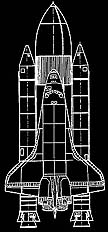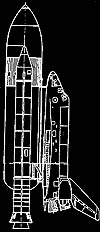
|
A REMARKABLE
FLYING MACHINE
| Designed
to operate on land, in the atmosphere, and in space, the Space Shuttle
combines features of a rocket, an aircraft, and a glider. No other
flying machine is launched, serves as a crew habitat and cargo carrier,
maneuvers about in orbit, then returns from space for an unpowered
landing on a runway, and is ready to do it all again in a few weeks.
The Space Shuttle's liquid-propellant main engines and turbopumps
operate reliably at extremely high temperatures and pressures, mission
after mission. Its main engines and solid rocket motors are the first
ever designed for reuse. |
|
SPACE
SHUTTLE
The
Space Shuttle is the only U.S. vehicle currently used for human
spaceflight. Three Shuttle orbiters are in service: Discovery, Atlantis,
and Endeavour. Two orbiters have been destroyed and their two crews
of seven astronauts have died in accidents: Challenger during launch
in 1986 and Columbia during reentry in 2003. Since the first launch
on April 12, 1981, Shuttles have flown two to nine missions a year,
except when flights were suspended after the accidents.
The
Space Shuttle travels from the Vehicle Assembly Building at Kennedy
Space Center, Florida, to the Cape Canaveral launch complex on a
four-story tracked crawler-transporter vehicle, as shown by the
model. At a maximum speed of 1.6 kilometers (1 mile) per hour, the
trip to the launch pad takes about five hours.
1:15 scale model
Gift of
Rockwell International
See the NASA History web site on the 25th anniversary of STS-1
|
|
 |
 |
| ORBITER |
| Piloted vehicle
that goes into space, carrying as many as eight crew members on missions
lasting up to two and a half weeks. |
| Length: |
37 m (122 ft) |
| Wingspan: |
24 m (78 ft) |
| Weight: |
77,000 kg (171,000 lb) |
| Total thrust: |
5 million newtons (1.1
million lb) |
| Propellants: |
Liquid hydrogen and liquid
oxygen |
| Orbital velocity: |
27,700 km/h (17,300 mph) |
| Manufacturer: |
Rockwell International |
| EXTERNAL
TANK |
| Propellant
tank for the three main engines on the orbiter; released when empty,
about eight minutes after launch, and not recovered. |
| Length: |
47 m (154 ft) |
| Diameter: |
8.4 m (27 ft 6 in) |
| Weight: |
720,000 kg (1.6 million
lb) |
| Manufacturer: |
Martin Marietta Corp. |
| SOLID
ROCKET BOOSTERS |
| Twin rockets
used for lift-off; burn out after two minutes, fall into the ocean,
recovered and refurbished for other launches. |
| Length: |
45 m (149 ft) |
| Diameter: |
3.7 m (12 ft) |
| Weight: |
585,000 kg (1.3 million
lb) |
| Total thrust: |
29.5 million newtons (6.6
million lb) |
| Propellants: |
Solid (ammonium perchlorate
and powdered aluminum) |
| Manufacturer: |
Morton Thiokol Corp. |
|
|